Last Updated on January 6, 2024 by Greg Gillson
What types of bird feeders do birds like? How do you choose a bird feeder that birds will like? What are the different kinds of bird feeders?
There are 7 major different kinds of bird feeders that attract different kinds of birds.
- Finches and chickadees like tube feeders
- Cardinals and grosbeaks like hopper feeders
- Doves and sparrows like platform or tray feeders
- Goldfinches and siskins like thistle or Niger feeders
- Hummingbirds and orioles like nectar feeders
- Orioles and tanagers like fruit feeders
- Woodpeckers and nuthatches like suet feeders
Please continue reading to get a more detailed list of birds at each feeder type. Learn also the variations available for each style of bird feeder. Find out which bird feeders are best for the birds you want to attract.
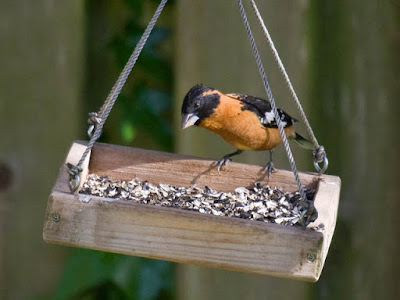 |
|
A Black-headed Grosbeak eats from a homemade platform feeder.
Photo by Greg Gillson
|
1. Platform bird feeders
The platform or tray bird feeder is the simplest kind of bird feeder. It is basically one step up from spreading seed on the ground.
Platform bird feeders are open from the top allowing birds to choose whatever kind of seed or other bird food they wish to eat from whatever you place upon this feeder.
Any kind of bird will be attracted to a platform bird feeder, depending upon what food you offer. And that’s the beauty of a platform feeder–you can put any and all kinds of food in the tray. You can put in seeds, fruits, bread, pasta, rice, nuts, jelly, peanut butter, anything! You can even add a dish of water, if you wish.
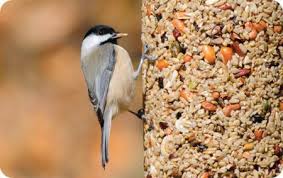
Because of their open and inviting style, this feeder attracts the most birds. Platform feeders attract the most kind of birds.
The kinds of birds that especially like platform feeders (depending upon where you live) include sparrows: White-crowned Sparrows, White-throated Sparrows, Chipping Sparrows, Dark-eyed Juncos, Golden-crowned Sparrows, Spotted Towhees, Eastern Towhees, California Towhees, Song Sparrows, Fox Sparrows, American Tree Sparrows.
Platform bird feeders attract ground-feeding birds like Mourning Doves and Eurasian Collared-Doves, Common Ground-Doves, White-winged Doves, and Band-tailed Pigeons. Also feeding on larger platform feeders will be California Quails, Gambel’s Quails, and Bobwhite.
Of course, Black-headed Grosbeaks, Rose-breasted Grosbeaks, Blue Grosbeaks, Indigo Buntings, Lazuli Buntings, Varied Buntings, Painted Buntings, Northern Cardinals, and similar birds will eat at platform feeders.
Platform feeders will attract American Goldfinches, Lesser Goldfinches, Pine Siskins, House Finches, Purple Finches, Cassin’s Finches, Evening Grosbeaks, and Common Redpolls.
And platform bird feeders will also attract Black-capped Chickadees, Chestnut-backed Chickadees, Mountain Chickadees, Carolina Chickadees, Oak Titmouses, Tufted Titmouses, White-breasted Nuthatches, Red-breasted Nuthatches, Pygmy Nuthatches, Brown-headed Nuthatches.
If you offer the right food, you may have Downy Woodpeckers, Red-bellied Woodpeckers, Northern Flickers, Gila Woodpeckers.
Did I leave any birds out? Yes, I did.
You see, several more undesirable birds may visit your platform feeders. As single birds they might not be undesirable, but as flocks (or simply because of their large size) they can take over a feeder, chase the other birds away, and quickly eat all the food. Such birds include California Scrub-Jays, Blue Jays, European Starlings, Brown-headed Cowbirds, House Sparrows, Red-winged Blackbirds, Common Grackles, American Crows.
And the open-to-all design can attract squirrels, rats, raccoons, opossums, skunks, deer, bears, dogs, and probably other non-birds I haven’t imagined. Of course, this is true for all bird feeders. However, the platform feeder will attract the most non-birds and pest birds.
The bottom of the platform feeder is generally a wire mesh. This allows rainwater to drain through so the food doesn’t stay wet. That’s fine if you live in an area that doesn’t get much rain. Or snow to cover it completely.
You could hang a platform feeder under the eaves or carport. But a simple solution to protect the bird food from the weather is to add a roof.
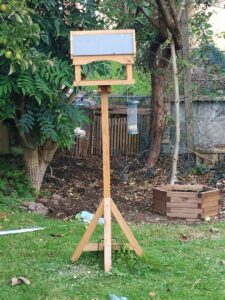
Small platform feeders may hang. Larger platform feeders are often pole mounted. Really large platform bird feeders have four legs and may sit closer to the ground.
A bowl or saucer sitting on the railing of your deck is an example of a simple DIY (do it yourself) homemade platform bird feeder.
Platform bird feeders also can be mounted with suction cups as a window feeder. This can bring birds right up to your living room for your enjoyment!
2. Tube bird feeders
Perhaps you don’t want a free-for-all smorgasbord that platform feeders provide. Tube feeders are designed to limit the kinds of birds eating at your feeder. They also eliminate many of the non-bird feeder raiders.
Tube bird feeders are designed to offer seeds specifically to finches. Finches feed in trees, more than on the ground.
So they like these feeders arranged vertically, rather than horizontally.
Tube feeders have several feeding ports at various heights on the side of the feeder.
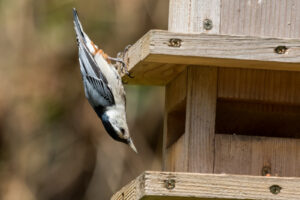
Tube bird feeders are often filled with black oil sunflower seeds.
What birds eat from tube feeders? Sunflowers in tube feeders attracts House Finches, Purple Finches, American Goldfinches, Lesser Goldfinches, Pine Siskins. Chickadees and nuthatches will also eat sunflower seeds from these tube feeders.
Feeding ports on some tube bird feeders are adjustable to dispense either smaller or larger seeds.
These feeders are best filled with only one kind of seed. Larger seeds if filled with a mixed seed blend may get stuck and block the feeding ports.
Filling with only one type of seed keeps birds from making a mess. They often throw out the seeds they don’t like in order to reach the ones they do.
Some tube bird feeders have a small shelf or tray on the bottom.
This catches any spilled seeds. It also allows larger seed eaters like cardinals, grosbeaks, and even Mourning Doves to feed at them. But it also allows squirrels to feed. So you may decide whether this might be a problem in your backyard.
The tube feeder with tray above also has a sloped roof that may help keep some rainwater off the seed. I have a feeder similar to this one that we hung under our bedroom window awning for added weather protection. We fill it with hulled sunflower seeds broken into smaller pieces in a “no mess” feeding station.
Some tube feeders may be enclosed in a cage to keep out squirrels and larger birds.
3. Hopper bird feeders
Hopper bird feeders have a roof to help keep seeds dry.
It fills from the top and dispenses from the bottom as seed is eaten from a lower tray.
In many ways this is a combination between a platform feeder and a tube feeder. Thus, the hopper type bird feeder is often considered the best bird feeder.
Because different sized seeds can be dispensed, this is a good feeder to use for mixed seed. The tray allows larger birds to feed. But there is usually not enough room for a whole flock of birds to land and eat all the food at once as on a platform feeder.
Nearly all birds will eat from a hopper feeder.
Cardinals, grosbeaks, sparrows, and finches will like foods offered in this type of feeder. Mourning Doves and Red-winged Blackbirds are about the largest birds that feed on a medium or small hopper feeder.
Larger hopper bird feeders may be designed with a weight-sensitive perch that closes the feeding ports when something heavy, like a squirrel, climbs on. Some are adjustable so that feeding ports may also close for heavy starlings or flocks of grackles.
4. Thistle bird feeders
Thistle bird feeders are also known as Finch feeders.
They dispense very tiny Niger seeds. You may see this seed sold under the Nyjer trademark by the Wild Bird Feeding Institute.
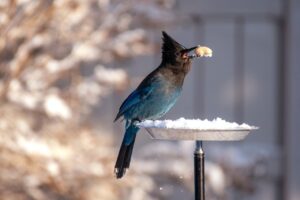
Niger seed is not thistle seed. But it is very small. In order for it to be used in a bird feeder the feeder uses very small mesh. See my article on thistle feeders and seed.
American Goldfinches, Lesser Goldfinches, Pine Siskins, Common Redpolls, and sometimes House Finches like thistle feeders.
The mesh used to contain the Niger seed may be a metal mesh with a feeder design similar to a tube feeder. Rather than several feeding ports, the seeds can be pulled through the mesh at any point.
Another popular Niger seed bird feeder is a nylon mesh bag, called a Thistle Sock. And, yes, it does look like a white sock hanging on your bird feeder!
5. Nectar bird feeders
Hummingbirds and orioles drink sugar-water, or nectar, from specially designed nectar bird feeders. Sometimes woodpeckers like drinking nectar from these feeders, too!
Hummingbirds in the United States and Canada that are found in towns include Ruby-throated Hummingbirds, Anna’s Hummingbirds, Rufous Hummingbirds, Costa’s Hummingbirds, Allen’s Hummingbirds, Black-chinned Hummingbirds, and Broad-tailed Hummingbirds.
Woodpeckers that like nectar feeders include Downy Woodpeckers, Red-bellied Woodpeckers, and Gila Woodpeckers.
Baltimore Orioles and Bullock Orioles like oriole nectar feeders.
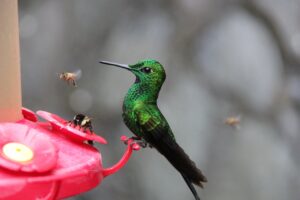
Make your own nectar with a 4 parts water and 1 part sugar ratio. See my article on how to make hummingbird food.
6. Fruit and Oriole bird feeders
Cut up slices of fruit–grapes, apples, oranges, and any other, may be placed on a platform feeder or impaled on a branch.
Mockingbirds, Brown Thrashers, American Robins, Varied Thrushes, and Hermit Thrushes like fruit.
More ideas of different kinds of fruit you can feed birds, and what birds like fruit are found on my page: fruit to feed wild birds
Special oriole feeders have spikes to hold orange halves. These feeders also include dishes to hold grape jelly–an oriole favorite!
Many also include a reservoir to fill with nectar.
These special oriole feeders attract Baltimore Orioles, Bullock’s Orioles, Hooded Orioles, Western Tanagers, Scarlet Tanagers, and Summer Tanagers.
Other birds like the grape jelly, including Rose-breasted Grosbeaks, House Finches, and woodpeckers.
7. Suet bird feeders
A final type of bird feeder is the suet feeder. These feeders offer suet, rendered fat, to birds. Suet is like a big fat delicious grub for insect eating birds!
Suet can melt or go rancid at higher temperatures. So in many places this is a food offered only during winter.
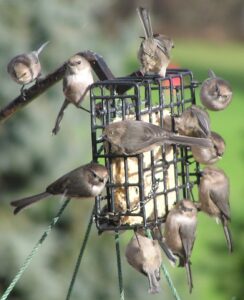
Birds that like suet are Downy Woodpeckers, Red-bellied Woodpeckers, Bewick’s Wrens, Carolina Wrens, Bushtits, White-breasted Nuthatches, Yellow-rumped Warblers, Red-breasted Nuthatches, Townsend’s Warblers, Northern Flickers, Black-capped Chickadees, Ruby-crowned Kinglets and similar birds.
Suet is often made into cakes or blocks and presented in a suet cage. This prevents a larger bird or animal from taking the suet away.
Cages may be hung on longer chains that swing about and keep heavier starlings and blackbirds from getting too much.
Upside-down suet bird feeders also make it harder for starlings and blackbirds to get to the suet.
Read my article on Where to hang a suet feeder for more information.
Suet often has seeds or nuts or fruit mixed in.
Mealworms are often fed in bowls on platform feeders to attract Eastern and Western Bluebirds. Some mealworm and seed cakes are specially made to fit in the suet feeder cages.
Peanut butter is sometimes added to suet or substituted for the suet.
Sometimes hollowed out branches have holes filled with suet plugs for a more rustic or natural suet feeder.
Wrapping Up
The 7 major types or kinds of bird feeders are platform, tube, hopper, thistle, nectar, oriole, and suet feeders.
Each type of bird feeder has certain kinds of birds that are especially attracted to them. Each type of bird feeder has a special food that attracts birds best. Different birds like different kinds of feeders.
Feeders come with many options. There are window bird feeders and squirrel-proof feeders. There are baffles to prevent squirrels from above or below. There are seed catchers to help reduce waste and spillage.
Some bird feeders have cages to keep larger birds away. Some bird feeders, such as the platform type, are generic as to what foods are offered and what birds come to them. Others, like a hummingbird feeder, is very restrictive to only one kind of food and one kind of bird.
To attract the most different kinds of birds to your yard experiment with several different kinds of foods in different bird feeders. The best type of bird feeder for you depends upon what birds you want to attract. The more variety of foods you offer, the more different kinds of birds you can attract to your backyard!
Frequently Asked Questions
What is an alternative to a bird feeder?
The best alternative to a bird feeder for you depends on your goals and situation. Here are some options to consider:
Attract birds naturally:
- Plant native trees and shrubs: These provide natural food sources like berries, seeds, and insects, encouraging a wider variety of birds.
- Create a water feature: A birdbath or small pond adds beauty and hydration for birds, who may also use it for bathing.
- Leave some fallen leaves and brush piles: These create shelter and attract ground-feeding birds and insects, which in turn attract insectivorous birds.
What is the easiest homemade bird feeder?
There are several contenders for the title of “easiest homemade bird feeder,” each with its own level of simplicity and appeal. Here are three top contenders:
1. The Pine Cone Paradise:
- Materials: Pine cone, peanut butter, birdseed.
- Instructions: Spread peanut butter on the pine cone scales, then roll it in birdseed. Hang it with twine or string.
- Pros: Super fast, fun for kids, attracts a variety of birds, biodegradable.
- Cons: Not weatherproof, needs frequent refilling.
2. The Recycled Can Cafe:
- Materials: Empty tin can (coffee cans work well), awl or hammer and nail, twine, birdseed.
- Instructions: Poke holes in the bottom of the can for drainage. Attach twine for hanging. Fill with birdseed.
- Pros: Reusable, sturdy, easy to find materials, good for larger seeds.
- Cons: Requires some tools, can be hot for birds in direct sun.
3. The Citrus Surprise:
- Materials: Half an orange or grapefruit, peanut butter, birdseed.
- Instructions: Scoop out the fruit, leaving a thick rind. Spread peanut butter inside and roll in birdseed. Hang with a stick or skewer.
- Pros: Eye-catching, biodegradable, attracts variety of birds, uses recycled materials.
- Cons: Not weatherproof, needs quick assembly and replacement.
What are the benefits of feeding birds?
There are many benefits to feeding birds, for both the birds themselves and for you as a backyard birdwatcher! Here are some of the key advantages:
Benefits for birds:
- Supplemental food: Bird feeders provide an additional source of food, especially during challenging times like harsh winters or periods of food scarcity. This can help birds maintain their energy levels, improve their breeding success, and ultimately increase their survival rates.
- Improved health: A diverse diet that includes both natural food sources and supplemental feeders can lead to healthier birds with stronger immune systems. This can make them more resistant to diseases and parasites.
- Stress reduction: By providing reliable food sources, you can help birds spend less time foraging and more time resting, socializing, and caring for their young. This can reduce stress and improve their overall well-being.
- Habitat enhancement: Bird feeders can attract a variety of bird species, creating a more diverse and vibrant ecosystem in your backyard. This can benefit other wildlife like insects and small mammals that rely on birds for food or pollination.
Benefits for you:
- Connecting with nature: Observing birds at your feeder is a fantastic way to connect with nature and appreciate the beauty and diversity of the avian world. It can be a relaxing and therapeutic activity, improving your mood and reducing stress.
- Learning opportunities: Birdwatching can be a fascinating hobby that teaches you about different bird species, their behaviors, and their ecological roles. It can be a great learning experience for both adults and children.
- Entertainment: Watching birds can be incredibly entertaining! Their colorful plumage, lively antics, and melodious songs can bring joy and wonder to your day.
- Pest control: Some birds, like chickadees and nuthatches, are excellent insect eaters. By attracting these birds to your feeder, you can help control unwanted pests in your garden or yard naturally.
Related Articles:


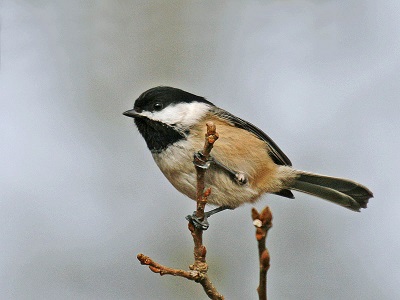
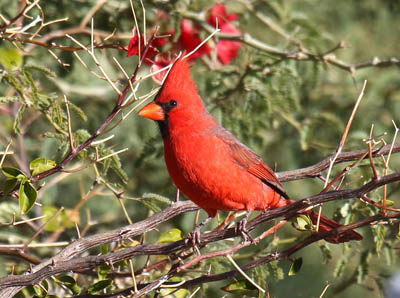
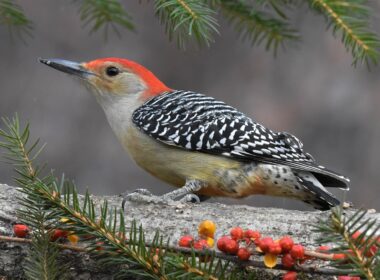
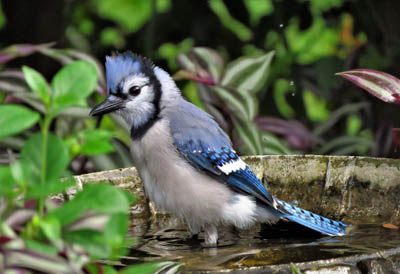
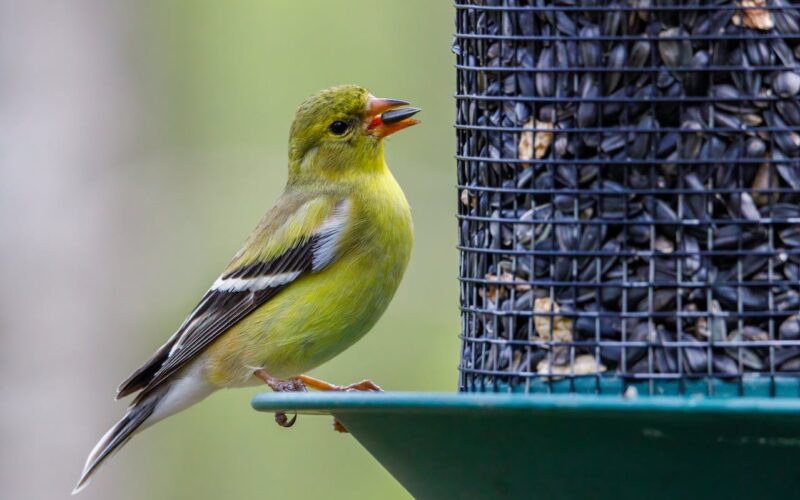
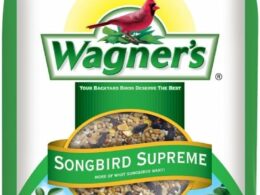
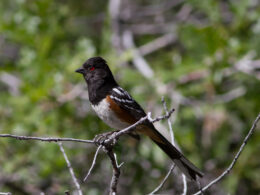
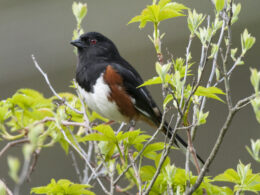
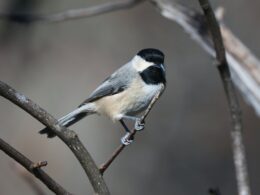
Thank you. Very informative in a language I could understand. Pictures of the types of feeders also helped. I had never heard the term "Hopper" feeder before.
Glad to help!
Great article Greg ! This was very helpful in determining what type of feeder and seed I should use to attract the birds I would like. Also how to discourage some that I don't. Very good, helpful article.
Thank you. Your comments bring me joy!
What is your suggestion to keep ants out of hummingbird feeders?
Non-drip feeders and ant moats.
See my article: https://whatbirdsareinmybackyard.com/2020/03/why-wont-hummingbirds-come-to-my-feeder.html
Some additional ideas may be gleaned from an article on keeping bees out:
https://whatbirdsareinmybackyard.com/2020/06/how-do-i-get-rid-of-bees-at-my-hummingbird-feeder.html
A product called sticky foot. It's gooey and the ants cannot crawl up the Shepard's hook!
Thanks for the head's up on this product!
It cant get no better..its very understandable..its clear for everyone to understand.thanks cause o love to watch the red birds eat..
Thanks!